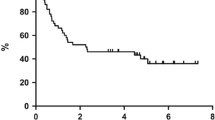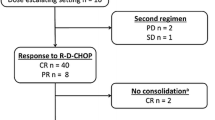Abstract
To assess efficacy and toxicity of rituximab and dose chemotherapy in high-risk diffuse large cell lymphoma, we conducted a controlled clinical trial to assess efficacy and toxicity of a dose-dense regimen CEOP-14 (cyclophosphamide, epirubicin, vincristine, and prednisone every 14 d) compared to CEOP-14 plus rituximab. One hundred and ninety-six patients were randomized to received CEOP-rituximab (cyclophosphamide 1500mg/m2, epirubicin 120 mg/m2, vincristine, and prednisone at standard dose and rituximab at 375 mg/m2) compared with the same chemotherapy administered every 14 d (CEOP-14). In an intent-to-treat analysis all patients were available for efficacy and toxicity. Complete response in CEOP-14 was observed in 73 cases (74%) and in 75 patients (76%) in the CEOP-R regimen (76%) (p=0.8). With a median follow-up of 53.4 mo, median has not been reached in time to tumor-progression (TTP) and overall survival (OS). Actuarial curves at 5 yr showed that TTP and OS in patients treated with CEOP-R were 74% and 67%, respectively, that were not statistical different when compared to CEOP-14, 72% and 65%, respectively (p=0.8). Acute toxicity was mild and well tolerated. The use of a dense-dose regimen is useful and well tolerated in patients with very high risk diffuse large cell lymphoma. The addition of rituximab did not improve outcome in these setting of patients.
Similar content being viewed by others
References
The International Non-Hodgkin’s Lymphoma Prognostic Factors Project. A predictive model for aggressive non-Hodgkin’s lymphoma. N Engl J Med 1993;329:987–994.
Shipp MA, et al. High-dose CHOP as initial therapy for patients with poor-prognosis aggressive non-Hodgkin’s lymphoma. J Clin Oncol 1995;13:916–923.
Bartlett NL, et al. Dose-escalated cyclophosphamide, doxorubicin, vincristine, prednisone and etoposide (CHOPE) chemotherapy for patients with diffuse large cell lymphoma. Cancer 2001;92:207–217.
Coiffier B. State of the art therapeutics. Diffuse large cell lymphoma. J Clin Oncol 2005;23:6387–6393.
Blayney DW, et al. Dose-intense chemotherapy every 2 weeks with dose intense cyclophosphamide, doxorubicin, vincristine and prednisone may improve survival in intermediate- and high grade lymphoma. J Clin Oncol 2003;21:2966–2973.
Itoh K, et al. Randomizded phase II study of bi-weekly CHOP and dose-escalation with prophylactic use of Lenogastrin (glycosilated G-CSF) in aggressive non-Hodhkin’s lymphoma. Ann Oncol 2002;13:1347–1355.
Pfreundschun M, et al. Two-weeks or 3-weekly CHOP chemotherapy with or without etoposide for the treatment of young patients with good-prognosis (normal LDH) aggressive lymphomas. Blood 2004;104:626–633.
Balzarotti M, et al. Intensified CHOP regimen in aggressive lymphoma. Maximal dose intensity and dose density of doxorubicin and cyclophosphamide. Ann Oncol 2002;13:1341–1346.
Portlock CS, et al. The NHL-15 protocol for aggressive non-Hodgkin’s lymphoma. A sequential dose-dense, dose-intense regimen of doxorubicin, vincristine and high-dose cyclophosphamide. Ann Oncol 2004;15:1495–1503.
Blayney DW, Mcguirre BW, Cruickshank SE, Johnson DH. Increasing chemotherapy dose density and intensity: phase I trials in non-small cell lung cancer and non-Hodgkin’s lymphoma. The Oncologist 2005;10:138–149.
Kluin-Nelemans HC, et al. Standard chemotherapy with or without high-dose chemotherapy for aggressive non-Hodgkin’s lymphoma. J Natl Cancer Inst 2001;93:22–30.
Strehl J, et al. High-dose chemotherapy followed by stem cell transplantation a first line therapy in aggressive non-Hodgkin’s lymphoma. A Meta-analysis. Haematologica 2003;88:1304–1315.
Lauchbuny AP, Habboubi N. Epirubicin and doxorubicin. A comparison of their characteristics, activity and toxicity. Cancer Treat Rev 1993;19:197–228.
Avilés A, et al. Intensive chemotherapy in the treatment of aggressive diffuse large cell lymphoma. Med Oncol 2004;21:269–272.
Avilés A, et al. Adjuvant radiotherapy in stage IV diffuse large cell lymphoma improve outcome. Leuk Lymphoma 2004;45:1385–1389.
Cheson BD, et al. Report of a International Workshop to standardize response criteria for non-Hodgkin’s lymphoma. J Clin Oncol 1999;17:1244–1251.
Fisher RI, et al. Comparison of standard regimen (CHOP) with three intensive chemotherapy regimens for advanced non-Hodgkin’s lymphoma. N Engl J Med 1993;328:1002–1006.
Zuckerman KS, Case DC Jr, Gams RA, Prasthofer ER. Chemotherapy of intermediate- and high-grade non-Hodgkin’s lymphoma with an intensive epirubicin-containing regimen. Blood 1993;82:3564–3573.
Avilés A, Calva A, Díaz-Maqueo JC, Talavera A, Huerta-Guzmán J, Vásquez E. Dose escalating of epirubicin in the CEOP-Bleo regimen. Leuk Lymphoma 1997;25:319–325.
Rossini F, et al. Long-term follow-up of patients with intermediate- and high-grade non-Hodgkin’s lymphoma treated with a combination of cyclophosphamide, epirubicin, vincristine, and prednisone. Cancer 2004,100:350–356.
Vose JM, et al. Phase II study of rituximab in combination with CHOP chemotherapy in patients previously untreated aggressive non-Hodgkin’s lymphoma. J Clin Oncol 2001;19:389–397.
Glass B, Kloess M, Engert W, Berdec B, Metzner L. Dose escalated CHOP + etoposide and repetitive autologous stem cell transplangtation (MegaCHOEP) with and without rituximab for primary treatment of aggressive NHL. Proc Assoc Clin Oncol 2005;23, 598s (Abstract 6654).
Author information
Authors and Affiliations
Corresponding author
Rights and permissions
About this article
Cite this article
Avilés, A., Nambo, M.J., Neri, N. et al. Dose dense (CEOP-14) vs dose dense and rituximab (CEOP-14+R) in high-risk diffuse large cell lymphoma. Med Oncol 24, 85–89 (2007). https://doi.org/10.1007/BF02685907
Received:
Accepted:
Issue Date:
DOI: https://doi.org/10.1007/BF02685907




